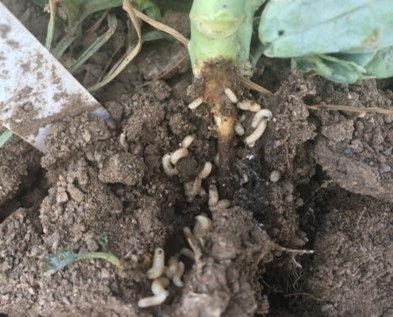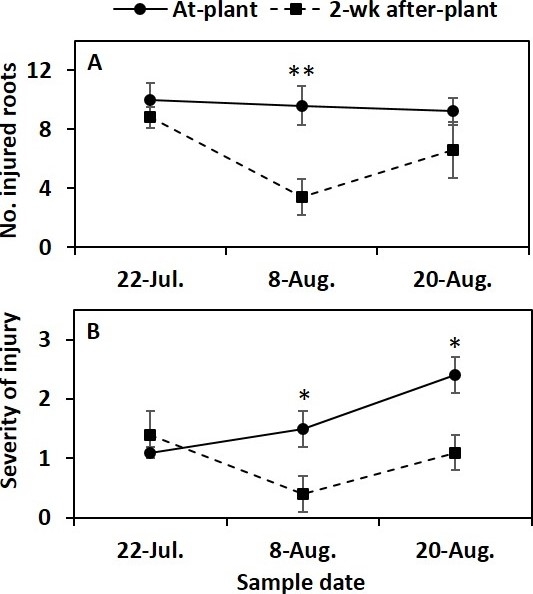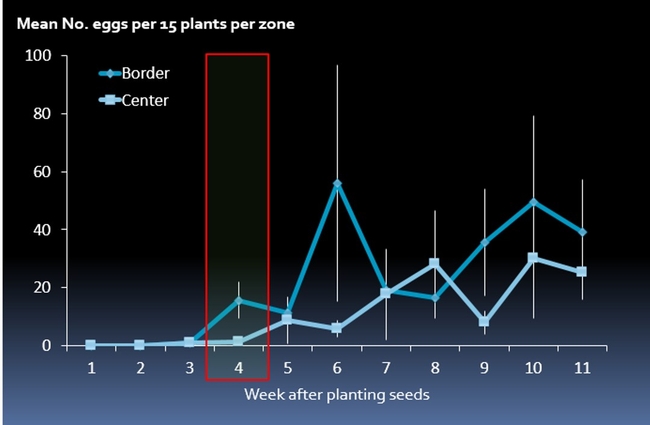Cabbage maggot (Delia radicum) (Fig. 1) is a serious and destructive pest of brassicas in the Salinas Valley of California. Brassica crops damaged by cabbage maggot are broccoli, cauliflower, cabbage, and Brussels sprouts. Cabbage maggot flies lay eggs in the soil around the base of a plant. Legless, white maggots feed on the taproot and affect plant development. After feeding for about 3 weeks, the maggot pupates in the surrounding soil for 2-4 weeks before emerging into an adult fly. The symptoms of cabbage maggot feeding in the root are yellowing, stunting, and slow growth.
Research showed that infestation by cabbage maggots in direct-seeded broccoli could be severe throughout the growing period, except the first 30 days after seed was planted. Typically, insecticide targeting cabbage maggot is applied immediately after planting seeds and before sprinkler is turned on. Efficacy studies with at-planting application of insecticide did not provide adequate cabbage maggot control. This suggested that insecticide applied at planting might be early relative to cabbage maggot incidence and thus, delaying application might be more effective.
In 2014 and 2015, replicated experiments were done in a commercial planting of baby turnip. The treatments were one chlorpyrifos application at planting and 2 weeks after planting seeds. A tractor-mounted sprayer was used to apply insecticide. Samples were collected and were transported to UCCE entomology laboratory where roots were evaluated for damage by cabbage maggot.
Results suggested that delayed application of effective insecticide suppresses cabbage maggot (Fig. 2). In a previous study, Joseph and Martinez (2014) showed cabbage maggot flies did not lay many eggs at the base of brassica plants until 3 weeks after plant emergence (Fig. 3), despite adult cabbage maggots in the field during early stages of plant development. Also, cabbage maggot infestation tend to be continuous after 3 week stage depending on local pest pressure and crop disturbances (e.g., harvest) in the surrounding fields (Joseph and Martinez 2014).
Delaying insecticide application would increase the likelihood of intercepting cabbage maggot larvae seeking roots. In the Salinas Valley of California, use of organophosphate insecticides including chlorpyrifos is regulated. This stringent regulation is forcing growers to seek alternate insecticides for cabbage maggot control. Previous study showed that clothianidin, thiamethoxam, and spinetoram as well as pyrethroid insecticides such as zeta-cypermethrin, fenpropathrin, bifenthrin, lambda-cyhalothrin, and pyrethrins were effective against cabbage maggot larvae, and efficacy was comparable to chlorpyrifos (Joseph and Zarate 2015). However, alternate insecticides are likely to be less persistent because they break down quickly (e.g., spinetoram) or become immobile in soil under field conditions because they bind to organic matter in contact (e.g., pyrethroid insecticides). Thus, as fewer effective older chemistries (e.g., organophosphate insecticides) are used against cabbage maggot because of use restrictions, delayed application of insecticide might be more critical.
For more details on this study, please read the published paper. http://cemonterey.ucanr.edu/files/248875.pdf
References
Joseph, S. V. 2014. Efficacy of at-planting and basal applications of insecticides on cabbage maggot in seeded-broccoli. Monterey County Crop Report. January/February 2010-2013. http://cemonterey.ucanr.edu/newsletters/i__b_ Monterey_County_Crop_Notes__b___i_50471.pdf
Joseph, S. V.,and J. Martinez. 2014. Incidence of cabbage maggot (Diptera: Anthomyiidae) infestation and plant damage in seeded brassica fields in California's Central Coast. Crop Prot. 62: 72-78.
Joseph, S. V., and J. Zarate. 2015. Comparing efficacy of insecticides against cabbage maggot (Diptera: Anthomyiidae) in the laboratory. Crop Prot. 77: 148-156.


